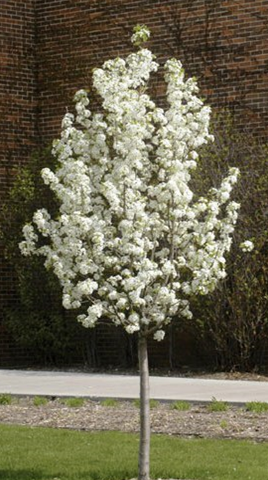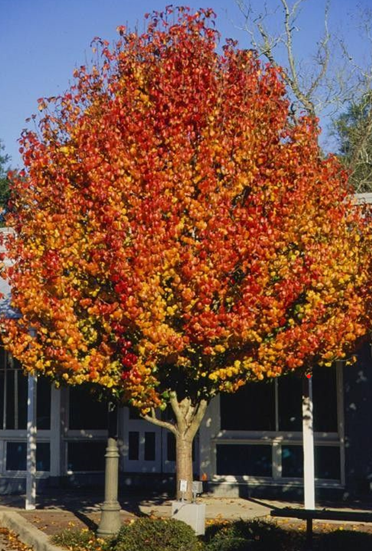by Ken Lain, the mountain gardener

This exquisite flowering tree starts spring with dazzling white flowers. Summer shade is created by thick dark green foliage that is the last tree to turn brilliant red in Autumn, even the winter bark is attractive. Ideal specimen tree for lawns, lining driveways, and specimens in small spaces. Even in the most challenging soil grows 30’x15′
Ornamental Flowering vs. Fruiting Pear Trees
Many ornamental pear trees produce very little fruit, sometimes less than 1/2″ in size (1 cm.), perfect for attracting wildlife and birds into gardens. The purpose of choosing an ornamental vs. fruiting pear trees is for its sparse to non-existent fruiting capability. Preferred for their showy flowers during the spring and striking red leaf color as the weather cools.
This deciduous tree has deep green, ovate leaves. Autumn chill turns the leaves into a kaleidoscope of red, bronze, and purple hues that thrives in all soil types, full sun, and mountain pH. Unlike their fruiting brothers, ornamental pears are resistant to fire blight, oak root fungus, and verticillium wilt.
‘Chanticleer’ has a pyramid-like habit, with a spread of around 15 feet wide.
‘Capital’ grows 35’x12′ feet.
‘Redspire’ and ‘Aristocrat‘ are the tallest of the ornamental pears growing to 50’x15’.
‘Bradford’ is the most massive overall pear reaching 40’x40′ size.
‘Jack’ pear is the smallest cultivar, only reaching around 15′ feet tall.
Each tree blooms with the same showy white flowers in spring and excellent fall colors.
History:
Named for Joseph-Marie Callery, who first sent specimens from China to Europe in the 1800s. The Callery pear was introduced to the US in the 1960s. It was promoted as a desirable tree for planting due to its beautiful white flowers and fast-growth.
Botanical Name Pyrus calleryana
Common Name Flowering Pear
Plant Type Deciduous tree
Mature Size 30 to 50 feet
Sun Exposure 6+ hours Full sun
Soil Type Moist, well-drained, tolerant of most soils
Soil pH Slightly acidic 6.0-7.5
Bloom Time Spring
Flower Color White
Autumn Foliage Red
Hardiness Zones 4 to 9
Native Area China, Vietnam
The Bradford cultivar of Ornamental pear has showy white blossoms with dark speckles in spring.
Planting an Ornamental Flower Pear

Choosing a site for this tree should allow for its mature height of at least thirty feet tall and twenty feet wide. The canopy tends to grow in a narrow upright shape. It can get quite cluttered unless pruned regularly, so avoid planting near electrical wiring or too close to a structure.
Soil and Sun
Ornamental Flowering pears grow in virtually any mountain soil conditions, including alkaline or clay soils. Ideally, it should have slightly acidic, well-drained soil. Still, its tolerant nature means it may be planted in difficult areas where other trees are hard to grow.
6+ Hours of sun are needed during the growing season for the best spring flowers and Autumn color. Seedlings may spring up in shadier areas.
Water newly planted trees regularly with a garden hose for at least one month (2 months in Summer). Automatic irrigation systems may not be sufficient initially. Water frequency will vary according to season, exposure and plant size.
April – Oct this Ornamental should be irrigated 2 x weekly
Nov – Mar this Ornamental should be irrigated 2 x monthly
Feed 4x Times per Year with either 7-4-4 All Purpose Plant Food, Soil Sulfur, or Humic. Here’s the recommendation by season:
Spring = 7-4-4 All Purpose Food + Soil Sulfur
Summer = 7-4-4 All Purpose Food + Humic
September = 7-4-4 All Purpose Food
December = 7-4-4 All Purpose Food
Pruning and Maintenance
Regular pruning in the first few years after planting controls this tree’s shape and form and makes it less susceptible to damage or disfigurement from storm or wind damage.

